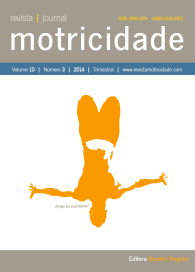Sport commitment in adolescent soccer players
DOI:
https://doi.org/10.6063/motricidade.2969Resumo
The aim of this study was to contribute to the postulates of the self-determination theory, the hierarchical model of intrinsic and extrinsic motivation by Vallerand, and social goals. A structural regression model was estimated to analyze the relations between social goals (responsibility and relationships), praise for autonomous behavior, satisfaction of the basic psychological needs and intrinsic motivation in commitment to sport. A sample of 264 young Spanish soccer players aged between 14 and 16 (M =14.74, SD =.77) participated in the study. Structural Equation Modeling results showed that the social responsibility goal, the social relationship goal and praise for autonomous behavior predicted perceived competence. Furthermore, the relationship goal also predicted the need for relatedness. Satisfaction of the basic psychological needs for competence and relatedness predicted intrinsic motivation. Intrinsic motivation positively predicted future commitment to sport. These results highlighted the importance of social goals, praise for autonomous behavior and psychological mediators in encouraging greater commitment in young soccer players. Future research should focus on the coach’s role in generating greater commitment to sport through the development of intervention methodologies based on social goals.
Downloads
Ficheiros Adicionais
Publicado
Edição
Secção
Licença
Os autores dos manuscritos submetidos para publicação deverão ceder, a título integral e permanente, os direitos de autor (copyright) à revista Motricidade e às Edições Sílabas Didáticas. A cedência de direitos de autor permite a publicação e divulgação do artigo em formato impresso ou eletrónico e entrará em vigor a partir da data de aceitação do manuscrito. Os autores concedem, ainda, os direitos para a revista Motricidade utilizar e explorar o respetivo artigo, nomeadamente para licenciar, ceder ou vender o seu conteúdo a bases de resumos/indexação ou outras entidades.
Nos termos da licença “Creative Commons”, os autores poderão reproduzir um número razoável de exemplares para uso pessoal ou profissional, mas sem fins comerciais. Nos termos da licença SHERPA/RoMEO, os autores poderão, ainda, disponibilizar/arquivar uma cópia digital final (versão postprint) do artigo no seu website ou no repositório científico da sua instituição.


